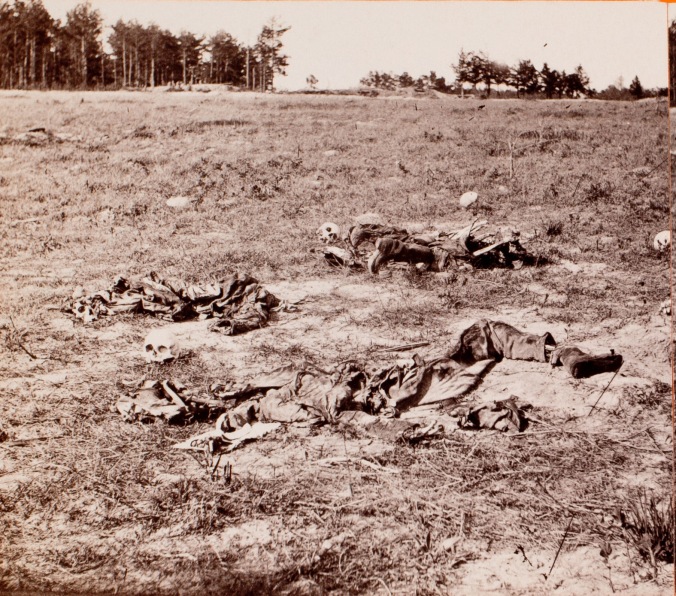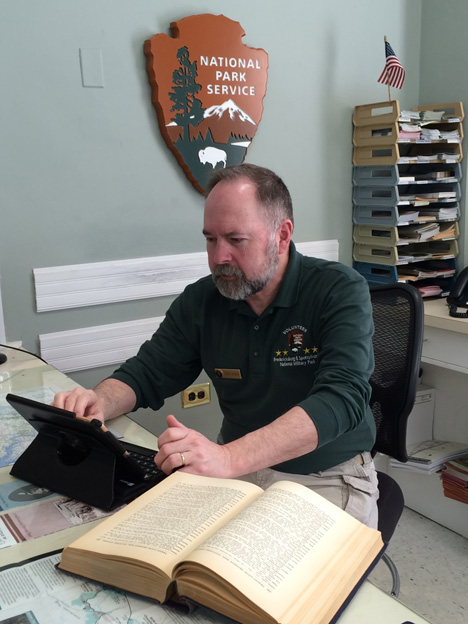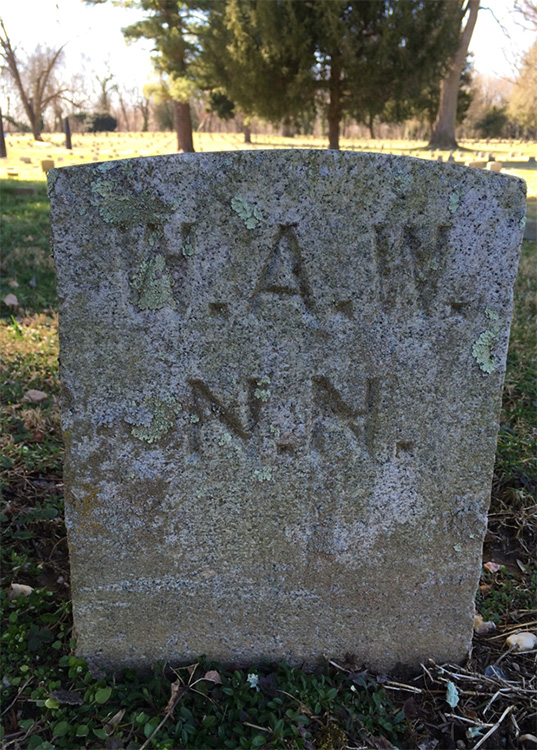 Unknown Until Now–The Ongoing Effort to Identify the Dead in the Fredericksburg National Cemetery, Peter Maugle, Mysteries and Conundrums weblog, May 18, 2019.
Unknown Until Now–The Ongoing Effort to Identify the Dead in the Fredericksburg National Cemetery, Peter Maugle, Mysteries and Conundrums weblog, May 18, 2019.
The aforementioned scene was repeated over 15,000 times in Fredericksburg and Stafford and Spotsylvania counties from 1866 to 1868. During this period, United States Army reburial details scoured the region cataloging and reinterring the remains of Union soldiers. Sadly, over 12,000 of the graves were simply marked, “Unknown.” It was the result of no standard issue identification for the soldiers, no protocol for properly identifying or marking graves, and the sheer magnitude of casualties incurred on a landscape that witnessed four of the costliest battles of the Civil War.
 Depending on when the death occurred, these graves, and their
improvised markers, could remain untended for several years. During that
time, the elements, animals, or unsympathetic locals could damage,
remove, or destroy makeshift markers. Thus, the noble efforts of the
living were for naught, as any indication of the grave’s occupant was
compromised or simply disappeared.
Depending on when the death occurred, these graves, and their
improvised markers, could remain untended for several years. During that
time, the elements, animals, or unsympathetic locals could damage,
remove, or destroy makeshift markers. Thus, the noble efforts of the
living were for naught, as any indication of the grave’s occupant was
compromised or simply disappeared.Upon the war’s culmination, the Federal government established national cemeteries throughout the south, to better administer and honor the multitude of Union dead there. United States Army officers were assigned to supervise parties of contracted workers, some of them former enslaved men, to reinter the remains of Union soldiers to the national cemeteries. They were to establish identification to the best of their ability, despite the inherent difficulties. It appears they took this responsibility quite seriously, which might be expected due to their vocation.
Unfortunately, many found it near impossible to discern any semblance of identity from decomposing corpses that had been buried in a haphazard manner several years prior. But, there were exceptions. Some rudimentary grave markers actually survived relatively unscathed, and made the identification process fairly straightforward, although it was certainly not common. There were many graves with only a partially discernable marker; a soldier who had their last name or initials stenciled on their equipment or uniform; an officer whose rank and unit could be determined from their insignia, but their name was not there. Instead of simply denoting these partially identified men as “unknown,” the officers supervising the reburial details made a point to record any tidbits of information. As a result, the Fredericksburg National Cemetery includes gravestones engraved with only initials, just a last name, or merely a first name. The rank or state may also be noted, and the original site of the grave was documented. Why would this be important? How did the officers think these fragments of information could possibly be utilized?
Fast forward 152 years later, as Steve Morin, a volunteer at Fredericksburg and Spotsylvania National Military Park, pores through the yellowed pages of an antique book, cross-referencing it with his iPad. Morin, a retired FBI research specialist and student of the Civil War, is attempting to determine the identity of an unknown soldier. He is not using DNA to perform this task, which makes it possible to ascertain the names of many World War II, Korean and Vietnam War soldiers whose remains had been anonymous. Instead, Morin is using a combination of rosters, books, and online resources to reveal the identities of these otherwise indistinguishable men.
 The process can be tedious and frustrating at times, but Morin has
the right mindset and background. Experience with the FBI instilled in
him a conviction to get the facts straight. No stone is left unturned as
Morin strives to make the most accurate identification possible. He
scrutinizes enlistment and payroll records, unit rosters, pension
applications, and a multitude of other sources. Morin must also take
into account misspellings or misinterpretations of writing from over 150
years ago. He might consider if the letter “A” was perhaps misconstrued
as an “H” on a crude grave marker, or if a soldier’s state of origin is
supposed to be MA, ME, or MG? Sometimes the clues come together like a
puzzle, and lead to a distinct probable identity. When a solid deduction
is made based upon all available evidence, the outcome is denoted in
the Fredericksburg National Cemetery records. The entries are never
definitive, however, and always reflect a degree of uncertainty. And if
there is insufficient evidence, the best course of action is to leave
the status as “Unknown.”
The process can be tedious and frustrating at times, but Morin has
the right mindset and background. Experience with the FBI instilled in
him a conviction to get the facts straight. No stone is left unturned as
Morin strives to make the most accurate identification possible. He
scrutinizes enlistment and payroll records, unit rosters, pension
applications, and a multitude of other sources. Morin must also take
into account misspellings or misinterpretations of writing from over 150
years ago. He might consider if the letter “A” was perhaps misconstrued
as an “H” on a crude grave marker, or if a soldier’s state of origin is
supposed to be MA, ME, or MG? Sometimes the clues come together like a
puzzle, and lead to a distinct probable identity. When a solid deduction
is made based upon all available evidence, the outcome is denoted in
the Fredericksburg National Cemetery records. The entries are never
definitive, however, and always reflect a degree of uncertainty. And if
there is insufficient evidence, the best course of action is to leave
the status as “Unknown.”Another researcher assisting with the identification project is Michael Taylor, a midshipman at the United States Naval Academy. Taylor was inspired to take on the task (in addition to his course load and other duties at the USNA), after he attended a tour of the Fredericksburg battlefield with his fellow midshipmen. The visit ended in the Fredericksburg National Cemetery, where Michael was struck by the over 12,000 unknown graves. He asked park staff if there was any way to go about identifying these soldiers. The arduous and complicated process necessary to establish any semblance of positive identification was explained to Taylor, but it did not deter the midshipman. Within a week, Michael delved into digital resources provided by the National Park Service and came up with promising leads. Now, over a year later, Taylor’s work has resulted in almost one hundred corrections and probable identifications for these previously unknown Civil War soldiers. Taylor, the son of a Vietnam War veteran, feels, “All those who served this country deserve to be remembered.”
When the Army reburial parties went about their grim task over 150 years ago, it is remarkable to consider they made every possible effort to somehow identify the fallen. Even if it only entailed part of a name, or their state of origin, there was an expectation that the task would someday be completed. Despite not knowing if there would be enhanced recordkeeping or organizations established to administer these places, the conviction was there. Otherwise, why bother inscribing “W.A.W.” on a gravestone? Now, with vast archives and multitudes of records available at a few keystrokes, the seemingly impossible is viable. Persistent research allows us the opportunity to fulfill the aspirations of our forebears by finally identifying these Civil War dead.
 Today, the gravestone in the Fredericksburg National Cemetery is
still inscribed with the same ambiguous lettering, “W.A.W.” (National
Park Service policy prohibits correcting gravestones for “errors of
fact”). However, after extensive research by volunteer Steve Morin, the
cemetery roster, maintained by the National Park Service and available
to the public, reflects that this grave very likely belongs to Private
George A. Wheeler of the 5th New Hampshire Infantry Regiment.
Documentation indicates a soldier from New Hampshire named Wheeler was
wounded at the Battle of Fredericksburg, removed to a field hospital,
and died a few days later. An assistant surgeon recorded Wheeler’s death
at the regimental hospital located near the O’Bannon farm in Stafford
County. Perhaps his comrades crafted the rudimentary grave marker that a
reburial detail found four years later. Their efforts, while diminished
by the elements, later provided an army officer with some vague
information associated with these remains. His copious notations
eventually enabled an amateur historian to piece together the story of
an otherwise unidentifiable casualty of our nation’s costliest conflict.
Now, anyone searching for this soldier, whether a family descendant or a
Civil War researcher, will be able to find him accordingly, whereas for
150 years prior, this soldier’s final resting place was essentially
unknown.
Today, the gravestone in the Fredericksburg National Cemetery is
still inscribed with the same ambiguous lettering, “W.A.W.” (National
Park Service policy prohibits correcting gravestones for “errors of
fact”). However, after extensive research by volunteer Steve Morin, the
cemetery roster, maintained by the National Park Service and available
to the public, reflects that this grave very likely belongs to Private
George A. Wheeler of the 5th New Hampshire Infantry Regiment.
Documentation indicates a soldier from New Hampshire named Wheeler was
wounded at the Battle of Fredericksburg, removed to a field hospital,
and died a few days later. An assistant surgeon recorded Wheeler’s death
at the regimental hospital located near the O’Bannon farm in Stafford
County. Perhaps his comrades crafted the rudimentary grave marker that a
reburial detail found four years later. Their efforts, while diminished
by the elements, later provided an army officer with some vague
information associated with these remains. His copious notations
eventually enabled an amateur historian to piece together the story of
an otherwise unidentifiable casualty of our nation’s costliest conflict.
Now, anyone searching for this soldier, whether a family descendant or a
Civil War researcher, will be able to find him accordingly, whereas for
150 years prior, this soldier’s final resting place was essentially
unknown.The important work done by Steve Morin, Michael Taylor, and others will be highlighted this year at the Fredericksburg National Cemetery’s Luminaria, held on Saturday, May 25th. For the last twenty-three years, local scouts have lit over 15,000 candles on Memorial Day weekend, one for every soldier interred at the cemetery. However, this year’s program will be uniquely different, as attendees will be encouraged to visit the graves of several previously unknown soldiers and learn about the remarkable process it took to have their stories told for the first time in over 150 years.
Images:
Second from the top---- Union graves on the Carpenter Farm, 1866. Note the identification on the board nearest the camera–Richard Ross, today buried in the National Cemetery.
Third from the top---- Park volunteer Steve Morin, former FBI Research Specialist
Fourth from the top---- Grave # 1221 in the Fredericksburg National Cemetery, believed to be that of Private George A. Wheeler
Full Text and Image Source: Mysteries and Conundrums weblog
No comments:
Post a Comment